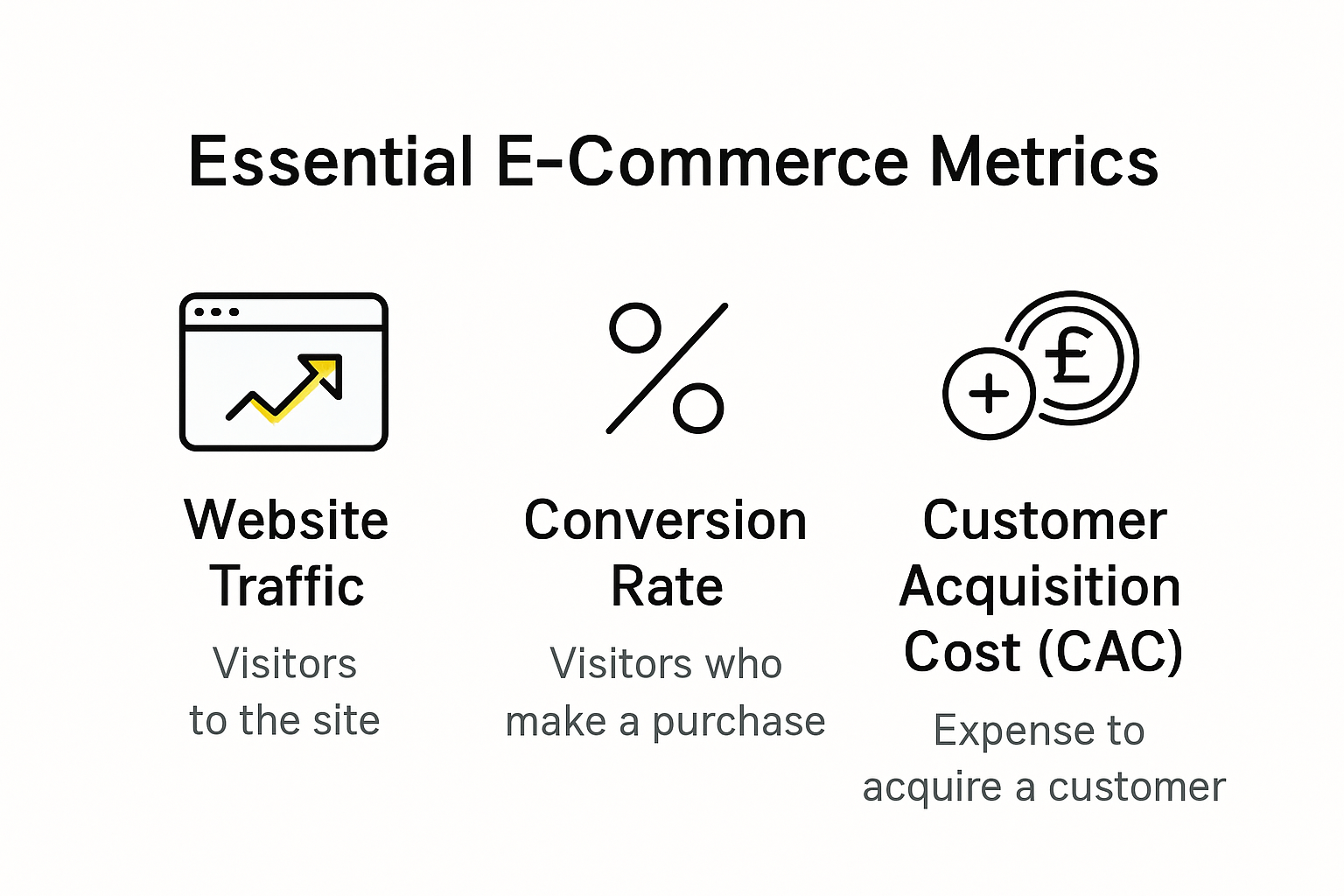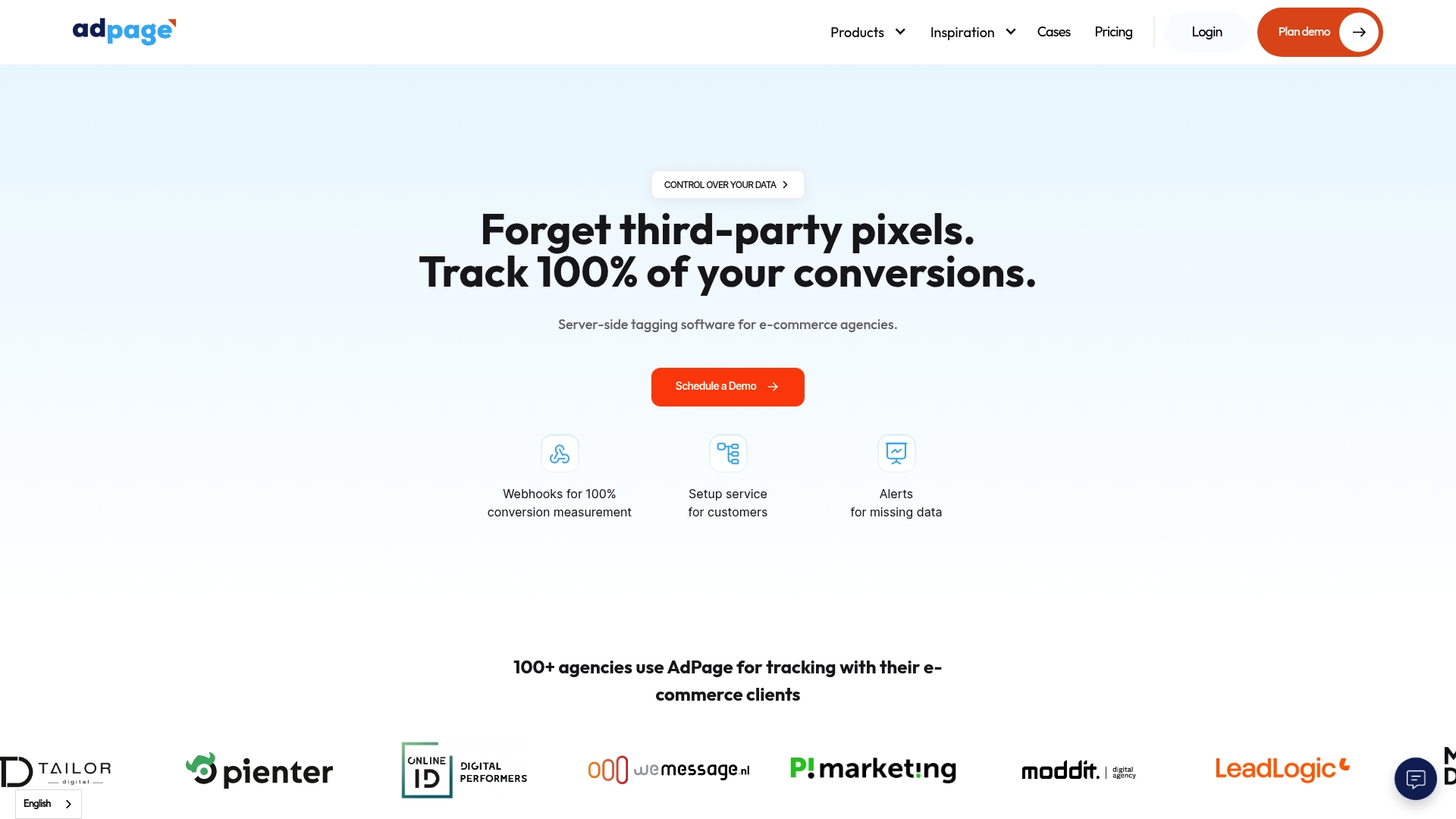E-commerce strategies are racing ahead in 2025 as brands fight to win more customers online. Here's something that stands out. Up to 69.57 percent of all online shopping carts are abandoned before any purchase happens. Yet the real surprise is that even small tweaks in tracking the correct metrics can turn these silent failures into actual sales. Miss out on the right data, and you may never know how much revenue is slipping through the cracks.
Table of Contents
- Essential E-commerce Metrics For Agencies And Brands
- Tracking Metrics To Improve Conversion Rates
- Advanced Analytics For E-commerce Growth
- Best Tools And Tips For Accurate Metric Tracking
Quick Summary
| Takeaway | Explanation |
|---|---|
| Track Essential Metrics | Focus on key metrics such as Website Traffic, Conversion Rate, Customer Acquisition Cost (CAC), and Customer Lifetime Value (CLV) to understand customer behavior and optimize marketing efforts. |
| Address Conversion Bottlenecks | Identify and analyze points of friction in the purchasing process, such as Checkout Process and Bounce Rate, to improve conversion rates and reduce cart abandonment. |
| Leverage Advanced Analytics | Utilize predictive analytics, machine learning, and sentiment analysis to transform raw data into strategic insights that anticipate customer needs and enhance operational efficiency. |
| Define Clear Performance Objectives | Establish precise Key Performance Indicators (KPIs) that align with business goals to enable effective data tracking and informed decision-making. |
| Implement Comprehensive Tracking Strategies | Develop a robust framework for data collection, integrating sophisticated tools and maintaining a focus on security, scalability, and cross-platform capabilities to support data-driven strategies. |
Essential E-commerce Metrics for Agencies and Brands
Tracking the right e-commerce metrics transforms raw data into strategic insights that drive business growth. Digital marketing professionals understand that numbers tell a complex story about customer behavior, operational efficiency, and potential revenue opportunities.
Key Performance Indicators for Digital Success
E-commerce metrics serve as the critical navigational tools for online businesses. Research from the University of Cambridge indicates that successful digital enterprises leverage comprehensive metric tracking to make informed decisions.
The most crucial metrics fall into several strategic categories. Website Traffic provides the foundational understanding of audience reach. This metric reveals how many potential customers interact with your digital storefront. By analyzing traffic sources, brands can identify which marketing channels generate the most engagement.

Conversion and Customer Value Metrics
Conversion Rate represents the percentage of visitors who complete a desired action, such as making a purchase. According to research published in the Journal of Digital Marketing, top-performing e-commerce brands maintain conversion rates between 2.5% and 5%, depending on their industry.
Customer Acquisition Cost (CAC) and Customer Lifetime Value (CLV) offer deeper insights into marketing efficiency. CAC measures the total expense of acquiring a new customer, while CLV estimates the total revenue a customer generates throughout their relationship with your brand. Tracking these metrics helps businesses understand the return on marketing investments.
To provide a clear overview, here is a summary table of essential e-commerce metrics, their definitions, and typical benchmark or insight drawn from the article:
| Metric | Definition | Typical Benchmark / Insight |
|---|---|---|
| Website Traffic | Number of visitors to digital storefront | Indicates audience reach |
| Conversion Rate | % of visitors completing a desired action | 2.5-5% for top performers |
| Customer Acquisition Cost (CAC). | Total expense of gaining a new customer | Lower is better for efficiency |
| Customer Lifetime Value (CLV). | Total revenue per customer over their relationship with brand | Understanding return on CAC |
| Cart Abandonment Rate | % of shopping carts abandoned before purchase | ~69.57% industry average |
| Average Order Value (AOV). | Average revenue per order | Used to implement revenue strategies |
| Bounce Rate | % of single-page visits without interaction | High rate signals UX/friction issues |
Advanced Analytics for Strategic Growth
E-commerce professionals must also monitor Cart Abandonment Rate, which reveals potential friction points in the purchasing process. A comprehensive study by Oxford Internet Institute suggests that reducing cart abandonment can directly increase revenue by up to 35%.
Additionally, mobile optimization metrics have become increasingly critical. Research from arxiv.org highlights that conversion rates vary significantly across different devices and browsers, emphasizing the need for comprehensive performance tracking.
By systematically monitoring these essential e-commerce metrics, agencies and brands can transform data into actionable strategies, ultimately driving sustainable growth and competitive advantage in the digital marketplace.
Implementing a robust analytics framework requires continuous learning, adaptation, and a commitment to understanding the nuanced story behind every data point.
Tracking Metrics to Improve Conversion Rates
Improving conversion rates requires a strategic approach to understanding and analyzing user behavior through precise metrics. E-commerce businesses need comprehensive insights that reveal why potential customers abandon their journey before completing a purchase.
Understanding Conversion Bottlenecks
Research from Moldstud reveals a staggering statistic: approximately 69.57% of online shopping carts are abandoned before purchase completion. This significant dropout rate highlights critical areas where businesses must focus their optimization efforts.
Bounce rate emerges as another crucial metric in understanding user engagement. Wikipedia's analysis indicates that a high bounce rate signals potential issues with website design, content relevance, or user experience. When visitors leave after viewing only one page, it suggests immediate friction points that prevent conversion.

Strategic Metric Analysis for Revenue Growth
Average Order Value (AOV) provides deeper insights into purchasing behavior. Yellowbrick Research emphasizes that understanding AOV allows businesses to implement targeted strategies for increasing revenue without necessarily expanding traffic.
Key conversion rate improvement strategies include:
- Checkout Process Optimization: Streamline steps to reduce abandonment
- User Experience Enhancement: Improve site navigation and load times
- Personalized Targeting: Develop more precise customer segmentation
Here's a process table summarizing key strategies to improve conversion rates, as described in the section:
| Strategy | Purpose | Expected Outcome |
|---|---|---|
| Checkout Process Optimization | Reduce friction/steps in checkout | Lower cart abandonment, higher conversions |
| User Experience Enhancement | Improve navigation, speed, usability | Increased engagement, lower bounce rate |
| Personalized Targeting | Segment and personalise communications | Higher conversion from better targeting |
Advanced Conversion Tracking Techniques
Successful e-commerce platforms implement multi-dimensional tracking approaches. This involves analyzing not just surface-level metrics, but understanding the complex interactions between different performance indicators.
Precise conversion tracking requires businesses to:
- Monitor user journey from initial site entry to final purchase
- Identify specific drop-off points in the sales funnel
- Implement real-time analytics for immediate insights
By adopting a comprehensive approach to conversion rate metrics, businesses can transform raw data into actionable strategies that directly impact bottom-line performance. The key lies in continuous measurement, analysis, and iterative improvement of the digital customer experience.
Advanced Analytics for E-commerce Growth
The digital marketplace demands sophisticated analytical approaches that transform raw data into strategic insights. Advanced analytics have become the cornerstone of intelligent e-commerce growth strategies, enabling businesses to make precise, data-driven decisions.
Predictive Analytics and Machine Learning
Research from Netscribes demonstrates the powerful potential of machine learning in e-commerce. Implementing advanced demand forecasting models can reduce stockouts by 40% and trim excess inventory by 35%, directly impacting operational efficiency and financial performance.
Predictive models enable businesses to:
- Anticipate customer purchasing patterns
- Optimize inventory management
- Develop personalized marketing strategies
- Reduce potential financial risks
Sentiment Analysis and Customer Insights.
Cutting-edge research from ArXiv reveals that AI-driven sentiment analysis systems can achieve remarkable accuracy of 89.7% in understanding customer interactions. This technological breakthrough allows businesses to gain unprecedented insights into customer experiences and preferences.
Key applications of sentiment analysis include:
- Understanding customer feedback nuances
- Identifying potential service improvement areas
- Developing more targeted communication strategies
- Enhancing overall customer satisfaction
Strategic Data Utilization
Research published on ResearchGate highlights the transformative power of big data analytics in marketing. Organizations implementing comprehensive data strategies have witnessed an average 20% increase in advertising budget effectiveness.
Successful advanced analytics strategies require:
- Integrated data collection systems
- Sophisticated analytical tools
- Continuous learning and adaptation
- Cross-functional collaboration
By embracing advanced analytics, e-commerce businesses can move beyond traditional reporting and develop dynamic, responsive strategies that anticipate market changes and customer needs. The future of digital commerce lies in intelligent, data-powered decision-making that transforms complex information into actionable insights.
Best Tools and Tips for Accurate Metric Tracking
Accurate metric tracking forms the backbone of successful e-commerce strategy. Digital businesses require sophisticated tools and strategic approaches to transform raw data into meaningful insights that drive growth and operational efficiency.
Defining Clear Performance Objectives
Harvard Business School research emphasizes the critical importance of establishing clear Key Performance Indicators (KPIs) aligned with specific business goals. Without well-defined objectives, data collection becomes a futile exercise in numerical accumulation.
Successful metric tracking requires businesses to:
- Identify Specific Goals: Determine precise measurement targets
- Select Relevant Metrics: Choose indicators directly connected to strategic outcomes
- Establish Baseline Measurements: Create comparative benchmarks for performance evaluation
Advanced Analytics and Technology Integration
Research from technological innovation platforms demonstrates that implementing machine learning and AI technologies can dramatically enhance data analysis accuracy. These advanced tools automate complex analytical processes, providing real-time insights and predictive capabilities.
Key technological considerations include:
- Automated data collection systems
- Machine learning predictive models
- Real-time analytics dashboards
- Integrated reporting mechanisms
Strategic Data Collection and Analysis
Professional e-commerce platforms require comprehensive approaches to metric tracking. Industry analysis from digital research institutes suggests that successful businesses implement multi-layered data collection strategies that go beyond surface-level metrics.
Critical components of effective metric tracking include:
- Consistent data collection protocols
- Cross-platform integration capabilities
- Robust security and privacy measures
- Scalable analytical frameworks
By adopting a holistic approach to metric tracking, businesses can transform complex data into actionable strategic insights. The most successful e-commerce enterprises understand that accurate measurement is not just about collecting numbers, but about creating a comprehensive understanding of customer behavior, operational performance, and market dynamics.
Implementing these advanced tracking methodologies requires continuous learning, technological adaptation, and a commitment to data-driven decision-making. The future of e-commerce belongs to those who can most effectively translate raw information into strategic competitive advantage.
Frequently Asked Questions
What are the essential e-commerce metrics to track in 2025?
Key metrics include Website Traffic, Conversion Rate, Customer Acquisition Cost (CAC), and Customer Lifetime Value (CLV). These metrics help understand customer behavior and optimize marketing strategies.
How can I reduce my cart abandonment rate?
To reduce cart abandonment, focus on optimizing the checkout process, enhancing user experience, and providing personalized customer targeting. Identifying friction points in the purchasing journey is crucial.
What role does predictive analytics play in e-commerce?
Predictive analytics helps e-commerce businesses anticipate customer purchasing patterns, optimize inventory management, and develop personalized marketing strategies, thereby improving operational efficiency.
How can I track the effectiveness of my marketing campaigns?
By defining clear Key Performance Indicators (KPIs) aligned with your business goals and using advanced analytics tools to monitor relevant metrics, you can effectively track the success of your marketing campaigns.
Turn E-commerce Insights Into Precise Growth with AdPage
You have seen how crucial accurate data and effective conversion tracking are for e-commerce success in 2025. The article highlighted common challenges like 'silent' cart abandonment, unreliable analytics, and missed opportunities in conversion rate optimization. Many brands continue to struggle with data loss and lack of precision when using outdated or traditional tracking systems. If you have ever questioned whether you are truly capturing every conversion or worried about gaps in your analytics, you are not alone.

Now is the time to close those gaps for good. AdPage empowers you to monitor 100 percent of your conversions using advanced server-side tagging solutions and GDPR-compliant consent management. With seamless integration for Shopify, WooCommerce, and Magento, as well as dedicated onboarding, you can finally make every visitor count. Discover how our reporting tools make it easy to transform your metrics into real business growth. Visit AdPage today and future-proof your e-commerce tracking before you fall behind the competition.



.png)
